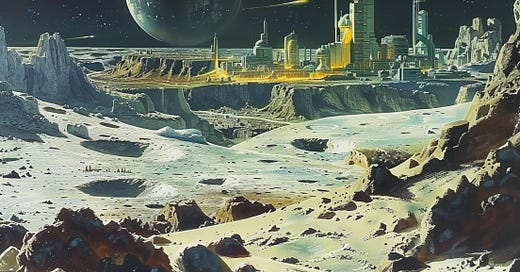🚀🌑 America finally returns to the Moon
It was a rough landing. Now let's pick ourselves up and get back to work.
Quote of the Issue
“We used to look up at the sky and wonder at our place in the stars. Now we just look down, and worry about our place in the dirt.” - “Cooper,” Interstellar
The Conservative Futurist: How To Create the Sci-Fi World We Were Promised
“With groundbreaking ideas and sharp analysis, Pethokoukis provides a detailed roadmap to a fantastic future filled with incredible progress and prosperity that is both optimistic and realistic.”
The Essay
🚀🌑 America finally returns to the Moon
Voyaging to the Moon isn’t easy. So full congratulations to Houston company Intuitive Machines, whose robotic Odysseus lander on Thursday became not only the first private spacecraft to land softly on Earth’s nearest neighbor — one launched into space by another private company, SpaceX — but also the first US vehicle to make the trip since Apollo 17 in December 1972.
Sure, Odysseus apparently toppled over such that its antennas aren’t pointed directly at Earth, as intended. But the landing near the Moon’s south pole is still a significant achievement. The Odysseus mission is the second attempt of NASA’s Commercial Lunar Payload Services initiative, in which private companies are paid to deliver cargo to the Moon's surface. The previous effort, Astrobotic's Peregrine, failed shortly after launch when a propulsion tank ruptured.
And even though this second attempt was hardly flawless, expect these missions to continue.
As Ars Technica’s space reporter Eric Berger writes, “The space agency believes that private companies will eventually get the hang of flying vehicles to the Moon. And once the service becomes more routine, it will cost NASA a fraction of the price it would pay for traditionally developed lunar services. In essence, then, NASA is taking some short-term risks for some long-term gains.”
Indeed, there’s some fictional precedent for a troubled Moon landing leading to big achievements in space. In the fantastically Up Wing Apple TV+ series For All Mankind, the Soviet Union beats America to the lunar surface in 1969. And when Apollo 11 makes it a few weeks later, the Eagle lunar module crash lands. After a bit of silent, Mission Control finally gets a message from Neil Armstrong:
Houston, Tranquility Base here. Do you read? …. Just wanted to let you know that the Eagle has landed. She might have clipped a feather or two on the way down, but she's still here, and so are we. … Not one of my better landings. But like we used to say in the Navy, any landing that you can walk away from is a good one. We had a rough start, but we've decided to pick ourselves up and get back to work.

In 1970, President Richard Nixon gave a speech ending NASA’s privileged budgetary status and lowering America’s human spaceflight ambitions - it’s worth noting that Nixon was badly shaken by the near-disaster of Apollo 13 — setting the stage for the Apollo 17 finale.
(As I have written previously, someone entering the Oval Office in December 1969 might have noticed — hanging on the wall, just to the right of President Nixon’s Wilson desk — the iconic “Earthrise” photo. It was taken from lunar orbit exactly a year earlier by Apollo 8 astronaut William Anders. But it was removed circa 1970, likely as Nixon lowered NASA's budget and ambitions. He apparently no longer wanted the reminder of what human explorers could achieve staring back while he made those decisions.)
Farewell to Apollo missions 18, 19, and 20, which would’ve further analyzed the moon’s radiation and surface dust in preparation for a semi-permanent scientific base. And after that? A year-long crewed flyby of Mars in the mid-1970s, followed by a Mars landing in the 1980s. But all the ambitious NASA plans that never happened in our reality do happen in For All Mankind, with continued high levels of federal R&D spending accelerating a wide variety of technological advances:
NASA establishes a moon base in 1973;
The Three Mile Island nuclear reactor avoids a meltdown in 1979 thanks to NASA tech;
The Space Shuttle travels to the moon in 1982;
Electric cars become commercially available in 1983, also thanks to NASA tech;
The World Wide Web emerges in 1985;
A space tourism company is founded in 1986;
Helios Aerospace wins a NASA contract to mine lunar deposits of Helium-3 in 1987;
Humanity's shift from fossil fuels to nuclear fusion ends the threat of global warming in 1989;
The US, USSR, and Helios launch missions to Mars in 1994;
Helios Mars base and Happy Valley Base are established on Mars in 1995;
A mineral-rich asteroid is captured and put into Mars orbit for mining.
The best time to pursue human mastery over the Solar System was a half century ago. The second best time is right now. Faster, please!
Micro Reads
Business and Economics
▶ The troubling decline in the global fertility rate - FT Opinion
▶ Why you, personally, should want a larger human population - Jason Crawford, Roots of Progress
▶ The Role of Infant Mortality in Closing the Life Expectancy Gap - St. Louis Fed
▶ Nvidia Hits $2 Trillion Valuation on Insatiable AI Chip Demand - WSJ
▶ Nvidia Hardware Is Eating the World - Wired
▶ It’s Nvidia’s World, We’re Just Living in a Simulation of It - Bberg Opinion
▶ The age of the unicorn is over - The Economist
Policy
▶ Artificial Intelligence Task Force: 10 Principles to Guide AI Policy - Adam Thierer, R Street
▶ For Obese Patients, Wegovy Is Worth the Cost - WSJ Opinion
▶ Regulate AI? How US, EU and China Are Going About It - Bberg
Are Place-Based Policies a Boon for Everyone - Richmond Fed
▶ What Texas can teach San Francisco and London about building houses - FT
▶ AI Billionaires Club Looks Like a New Gilded Age - Bberg Opinion
▶ Net Neutrality and the Future of State Broadband Regulation - AEIdeas
▶ Access to Medical Data Saves Lives - Marginal Revolution
AI
▶ AI Is Trying to Predict Your Death. It's Not as Scary as It Sounds. - Bberg Opinion
▶ Doing AI: Algorithmic decision support as a human activity - Arxiv
▶ The Impacts of Prediction AI on Scientists: Evidence from AlphaFold - SSRN
▶ Identifying the Social Sector AI Opportunity Gap - Stanford HAI
Health
▶ The weird way Alabama’s embryo ruling takes on artificial wombs - MIT Tech Review
▶ First gene-edited meat will come from disease-proof CRISPR pigs - New Scientist
▶ CAR-T therapy for multiple sclerosis enters US trials for first time - Nature
Clean Energy
▶ AI solves nuclear fusion puzzle for near-limitless clean energy - Independent
▶ Canada’s Climate Plan: Nuclear Power - WSJ Opinion
Robotics
▶ Bezos, Nvidia Join OpenAI in Funding Humanoid Robot Startup - Bberg
▶ A robot dog has learned to open doors with its leg - New Scientist
Space/Transportation
▶ A U.S.-Built Spacecraft Lands on the Moon for the First Time Since 1972 - NYT
▶ Moon Lander Is Lying on Its Side but Still Functional, Officials Say - NYT
▶ Putin’s Space Nuke Is So Crazy, It’s an Opportunity - Bberg Opinion
▶ Jeff Bezos’ New Glenn rocket finally makes an appearance on the launch pad - Ars Technica
▶ How antimatter engines could fly humans to other stars in just a few years - BI






